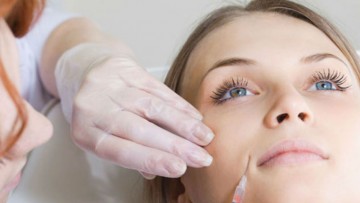The global brand president of Estée Lauder wants to cause a commotion. At the launch of the Estée Lauder New Dimension skincare range, Jane Hertzmark Hudis says: “We are breaking new ground and I believe by virtue of what we are creating here, we are creating a new disruption in the industry.”
She’s not far off. In terms of impact on skincare this is equivalent to the introduction of the Apple Watch and the company’s most important unveiling since Advanced Night Repair in 1982.
Why? Estée Lauder New Dimension is the first facial cream on sale in department stores to lift the skin to improve both visible volume and structure to create facial contours with instant results, from overnight to three days, yet also promising long-term effects of building volume over time. “Structure and volume is the new definition of beauty,” says Ms Hertzmark Hudis.
Injectables, notably fillers, have upped the ante for skincare companies
Volume? Structure? What about softness of lines and all the other beauty terms. For volume and structure is normally the vernacular of the cosmetic doctor’s office, in other words – the use of fillers. And given the sales figure of 27 million syringes of Juvéderm facial filler since 2004, it’s a strong market. But why do women increasingly want to create volume in their cheeks using the stuff?
“When you lose volume in the face, it makes the skin fall,” says Dr Nadine Pernodet, vice president, skin biology and bioactives for the Estée Lauder companies. “What we want to see is plumping and strengthening of the skin structures to improve the architecture of the face.”
Injectables, notably fillers, have upped the ante for skincare companies. Research by Juvéderm says that 25 per cent of women are actively considering facial fillers and this has struck alarm bells for skincare; if women spend their money in the doctor’s office, they no doubt will scrimp on buying creams. Injectables have “caused everyone to raise the bar and create the highest level [of results] that you can”, says Ms Hertzmark Hudis.
“The increase in injectables has led to such an interest in non-surgical interventions which by association has raised awareness of what skincare can do,” says Dr Tapan Patel, cosmetic dermatologist and owner-director of PHI Clinic in Harley Street.
At the ultra-natural end of the skincare spectrum, Sian Jones, co-founder of beauty brand Balance Me, has also had to sit up, and fast, to the impact of fillers. “Companies must work harder to produce the results that consumers are now looking for,” she says. “So two years ago we set ourselves a challenge to improve and support the structure of the skin from the inside rather than papering over the cracks. And now we have the Collagen Boost Collection to improve volume. But that wouldn’t have been possible in natural skincare until now.”
Yet Dr Howard Lancer sees this development from the other way round. “Rather than skincare mimicking the technology of the injectable, topical skincare technology is increasingly being developed to enhance the effect of injectable treatments,” says the Beverly Hills cosmetic dermatologist, who has his own eponymous skincare range.
Away from the department store counter, Fillerina combines six types of hyaluronic acids with peptides, amino acids applied topically to the skin to encourage collagen production to increase tissue volume in cheeks and lips after 14 days’ use. It’s not subtle in terms of its name or packaging, given the syringe like application tools. But it is seen as an alternative to a filler.
“I have clients who are scared of needles and Fillerina offers real results lasting three months,” says Dr Terry Loong, cosmetic doctor from The Skin Energy Clinic in London. As for the high street, M&S Cosmetox+ is inspired by muscle relaxants to make “credible claims when positioning our products as alternatives to injectables”, the company says.
But if you do get injections, don’t forget skincare. “Women look so strange if they only have injections, but don’t take care of their skin,” says Dr Erich Schulte, founder of QMS Medicosmetics. “It’s like going to Harrods and buying the most expensive television and then getting the wrong antennae. You need both.”
So although Estée Lauder New Dimension has a Shape + Fill Expert Serum and Expert Liquid Tape on sale in September, which acts like “the tape stars use to tape back wrinkles on the red carpet, giving a tighter feel and lift”, what about the texture in the skin? “In three days we found an increase in collagen production of 294 per cent and 236 per cent in elastic production, the ingredients for smooth glowing skin,” says Dr Pernodet.
Fighting statistics. But in terms of how they feel about themselves, women are still losing the battle of self-esteem. Research from Dove shows that 30 per cent of women actively do not look in the mirror and 90 per cent feel bad about themselves when they do.
Estée Lauder set out to do their own research on the matter. “We are the ultimate woman’s brand so we wanted to connect to how women expect and need to feel,” says Ms Hertzmark Hudis.
Some 750 women, using New Dimension over ten weeks, were tested with clinical, sensory and neuroscientific techniques, culminating in the women looking at before and after photos of themselves.
Why? “Neuroscience is designed to give bio-feedback, and measures reactions on an electronic matrix from heart rate and how the eyes and mouth move,” says Anne Carullo, senior vice president, global product development for Estée Lauder. “You can’t deny the way you feel in these tests.”
The results show that 91 per cent of the subjects displayed a positive change in attitude towards themselves. Changes were also noted after a matter of days. Quite staggering results. “There is a lot of pressure to look our best all the time,” says Dr Perondet. “And who wants to wait three months until they see results?” Why indeed?

